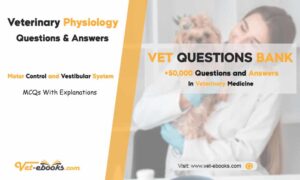In this Page, you’ll find multiple-choice questions (MCQs) covering the fundamental aspects of cellular physiology and cancer biology, essential for veterinary students. Understanding how cells function, grow, and respond to their environment is critical for grasping broader physiological processes. Additionally, questions on cancer biology will help you explore how normal cell regulation can go awry, leading to tumor formation, and the role of treatment strategies in combating cancer.
Basics of Veterinary Physiology: The Cell
Proteins and Their Functions
1 What is the primary role of proteins in physiological processes?
Correct! Well done!
Incorrect! The correct answer is shown in green.
Proteins are essential mediators of physiological changes in the body. They perform various functions, including catalysis, transport, structure, and signaling. Without proteins, vital processes such as enzyme activity, molecular transport, and cell signaling would not occur, making them fundamental to maintaining life.
2 How does protein shape influence its function?
Correct! Well done!
Incorrect! The correct answer is shown in green.
The three-dimensional shape of a protein, or its conformation, is crucial for its function. Proteins have specific binding sites that allow them to interact with other molecules. This interaction depends on the shape of the protein, which can change through mechanisms such as ligand binding, phosphorylation, and environmental factors like voltage.
3 Which of the following best describes the concept of allosteric regulation in proteins?
Correct! Well done!
Incorrect! The correct answer is shown in green.
Allosteric regulation occurs when a protein changes its shape in response to the binding of a ligand at a site other than its active site. This shape change can either enhance or inhibit the protein’s activity, depending on the specific function it regulates.
4 What is the function of phosphorylation in protein regulation?
Correct! Well done!
Incorrect! The correct answer is shown in green.
Phosphorylation involves the addition of a phosphate group (usually to serine, threonine, or tyrosine residues) on a protein. This process causes a conformational change in the protein, which can either activate or deactivate its function.
Cell Signaling and Membranes
5 What is the mechanism of action for G-protein–coupled receptors in cellular signaling?
Correct! Well done!
Incorrect! The correct answer is shown in green.
G-protein–coupled receptors (GPCRs) activate intracellular signaling cascades by triggering second messengers, such as cyclic AMP, leading to various cellular responses.
6 What is the primary structural component of biological membranes?
Correct! Well done!
Incorrect! The correct answer is shown in green.
The phospholipid bilayer forms the basic structure of biological membranes, providing a barrier that regulates the movement of molecules in and out of the cell.
7 Which molecules can pass through the lipid bilayer of a biological membrane without assistance?
Correct! Well done!
Incorrect! The correct answer is shown in green.
Small, uncharged molecules such as oxygen and carbon dioxide, along with hydrophobic molecules, can diffuse through the lipid bilayer without assistance.
8 How do voltage-dependent proteins function in cellular signaling?
Correct! Well done!
Incorrect! The correct answer is shown in green.
Voltage-dependent proteins, such as ion channels, respond to changes in membrane voltage by opening or closing, which regulates the movement of ions across the membrane.
9 What is the significance of the fluid mosaic model of biological membranes?
Correct! Well done!
Incorrect! The correct answer is shown in green.
The fluid mosaic model depicts biological membranes as dynamic structures where proteins can move within the lipid bilayer, allowing for flexibility and functionality.
Transport Mechanisms
10 Which of the following processes describes the movement of water across a semipermeable membrane?
Correct! Well done!
Incorrect! The correct answer is shown in green.
Osmosis is the movement of water across a semipermeable membrane from a region of lower solute concentration to a region of higher solute concentration, balancing the concentration on both sides of the membrane.
11 Which molecules typically require a membrane protein to facilitate their movement across the lipid bilayer?
Correct! Well done!
Incorrect! The correct answer is shown in green.
Large or polar molecules like glucose require transport proteins to cross the hydrophobic interior of the lipid bilayer efficiently.
12 What distinguishes active transport from passive transport in membrane dynamics?
Correct! Well done!
Incorrect! The correct answer is shown in green.
Active transport requires cellular energy, often in the form of ATP, to move molecules from areas of low concentration to areas of high concentration, against their natural gradient.
13 What role do transport proteins play in the membrane?
Correct! Well done!
Incorrect! The correct answer is shown in green.
Transport proteins act as selective gates, facilitating the movement of specific ions or molecules across the membrane based on size, charge, or other factors.
14 What is the function of the sodium-potassium pump in maintaining cellular homeostasis?
Correct! Well done!
Incorrect! The correct answer is shown in green.
The sodium-potassium pump maintains the proper ion balance by actively transporting sodium out of the cell and potassium into the cell using energy from ATP hydrolysis.
15 Which of the following describes the driving force behind passive transport of molecules?
Correct! Well done!
Incorrect! The correct answer is shown in green.
Passive transport is driven by electrochemical gradients, where molecules move from areas of high concentration to areas of low concentration without energy input.
16 What is the relationship between concentration gradients and the movement of molecules during diffusion?
Correct! Well done!
Incorrect! The correct answer is shown in green.
Diffusion is the passive movement of molecules from regions of higher concentration to lower concentration, aiming to reach equilibrium.
Muscle Physiology
17 Which of the following describes the process of muscle contraction at the molecular level?
Correct! Well done!
Incorrect! The correct answer is shown in green.
Muscle contraction occurs through the sliding filament mechanism, where myosin heads bind to actin and pull the filaments, using ATP hydrolysis to generate force.
18 What is the role of calcium ions (Ca2+) in muscle contraction?
Correct! Well done!
Incorrect! The correct answer is shown in green.
Calcium ions bind to troponin, causing a conformational change that shifts tropomyosin away from actin’s myosin-binding sites, enabling muscle contraction.
19 What is the primary function of troponin in muscle contraction?
Correct! Well done!
Incorrect! The correct answer is shown in green.
Troponin regulates muscle contraction by binding to calcium ions, which causes a shift in tropomyosin, exposing the actin sites for myosin binding.
20 What happens during the cross-bridge cycle in muscle contraction?
Correct! Well done!
Incorrect! The correct answer is shown in green.
The cross-bridge cycle involves the binding of myosin heads to actin, pulling the filaments past each other to shorten the muscle and generate force.
21 What is the role of the sarcoplasmic reticulum in muscle relaxation?
Correct! Well done!
Incorrect! The correct answer is shown in green.
The sarcoplasmic reticulum facilitates muscle relaxation by actively sequestering calcium ions, decreasing their concentration in the cytoplasm.
22 What occurs during excitation-contraction coupling in skeletal muscle?
Correct! Well done!
Incorrect! The correct answer is shown in green.
In excitation-contraction coupling, depolarization of the muscle membrane leads to the release of calcium from the sarcoplasmic reticulum, initiating contraction.
Cellular Homeostasis and Energy Use
23 What is the role of ATP in active transport processes?
Correct! Well done!
Incorrect! The correct answer is shown in green.
ATP provides the energy required for active transport, allowing molecules to move from areas of low concentration to high concentration, against their natural gradient.
24 How does the body prevent excessive water loss through capillaries during fluid exchange?
Correct! Well done!
Incorrect! The correct answer is shown in green.
Oncotic pressure, maintained by plasma proteins like albumin, draws water into the capillaries, preventing excessive fluid loss.
25 How do cells regulate the movement of large polar molecules and ions across their membranes?
Correct! Well done!
Incorrect! The correct answer is shown in green.
Large polar molecules and ions rely on transport proteins, either for passive facilitated diffusion or active transport, to cross the lipid bilayer.
26 What causes the release of calcium from the sarcoplasmic reticulum in muscle cells?
Correct! Well done!
Incorrect! The correct answer is shown in green.
Depolarization triggers calcium channels in the sarcoplasmic reticulum to release calcium ions, initiating muscle contraction.
Load More Questions
27 How do voltage-gated ion channels contribute to nerve signal transmission?
Correct! Well done!
Incorrect! The correct answer is shown in green.
Voltage-gated ion channels regulate nerve signal transmission by opening or closing in response to changes in membrane potential, allowing ions to flow through.
28 Why is passive transport important in cellular processes?
Correct! Well done!
Incorrect! The correct answer is shown in green.
Passive transport moves substances down their concentration gradient without using cellular energy, helping maintain homeostasis.
29 What determines the specificity of ligand binding to proteins in signal transduction pathways?
Correct! Well done!
Incorrect! The correct answer is shown in green.
Specificity in ligand binding is determined by the complementary shape and chemistry between the ligand and the binding site on the protein.
30 What is the key role of the sarcoplasmic reticulum during muscle relaxation?
Correct! Well done!
Incorrect! The correct answer is shown in green.
The sarcoplasmic reticulum ensures muscle relaxation by actively pumping calcium ions back into storage, lowering cytoplasmic calcium levels.
31 How do small hydrophobic molecules like oxygen pass through membranes?
Correct! Well done!
Incorrect! The correct answer is shown in green.
Small hydrophobic molecules like oxygen diffuse freely across the lipid bilayer without the need for transport proteins.
Fluid Exchange, Gradients, and Equilibrium
32 What is the function of biological membranes in compartmentalization?
Correct! Well done!
Incorrect! The correct answer is shown in green.
Biological membranes enable compartmentalization by isolating specific areas within the cell, allowing distinct biochemical processes to occur efficiently.
33 Which of the following molecules would most likely diffuse passively through the lipid bilayer of a membrane?
Correct! Well done!
Incorrect! The correct answer is shown in green.
Small hydrophobic molecules like oxygen can diffuse passively across the lipid bilayer without assistance from transport proteins.
34 How does the body prevent excessive water loss through capillaries during fluid exchange?
Correct! Well done!
Incorrect! The correct answer is shown in green.
Plasma proteins like albumin help maintain oncotic pressure, drawing water back into the capillaries and preventing excessive fluid loss.
35 What happens when the electrochemical gradient across a membrane reaches equilibrium?
Correct! Well done!
Incorrect! The correct answer is shown in green.
At equilibrium, molecules continue to move across the membrane, but there is no net change in concentration on either side.
36 How do transport proteins influence the movement of ions across membranes?
Correct! Well done!
Incorrect! The correct answer is shown in green.
Transport proteins offer selective channels for ions to pass through, allowing them to move along their electrochemical gradients efficiently.
37 What role does passive transport play in cellular processes?
Correct! Well done!
Incorrect! The correct answer is shown in green.
Passive transport allows substances to move along their concentration gradients without using cellular energy, helping maintain homeostasis.
38 How are concentration gradients related to diffusion in biological systems?
Correct! Well done!
Incorrect! The correct answer is shown in green.
In biological systems, diffusion occurs when molecules move from areas of higher concentration to areas of lower concentration, following their gradient.
39 What distinguishes active transport from passive transport in terms of energy use?
Correct! Well done!
Incorrect! The correct answer is shown in green.
Active transport requires cellular energy, usually in the form of ATP, to move molecules from areas of low concentration to high concentration, against their natural gradient.
40 How do voltage-gated ion channels help transmit nerve signals?
Correct! Well done!
Incorrect! The correct answer is shown in green.
Voltage-gated ion channels change shape in response to membrane potential changes, allowing ions to pass through, which helps generate and transmit nerve signals.
41 How does the sodium-potassium pump contribute to cellular homeostasis?
Correct! Well done!
Incorrect! The correct answer is shown in green.
The sodium-potassium pump maintains ion balance by actively transporting sodium out of the cell and potassium in, crucial for nerve function and cellular homeostasis.
42 What triggers the release of neurotransmitters at synapses?
Correct! Well done!
Incorrect! The correct answer is shown in green.
Depolarization causes voltage-gated calcium channels to open, allowing calcium ions to enter, triggering the release of neurotransmitters from synaptic vesicles.
43 How do ligand-binding events trigger signal transduction cascades?
Correct! Well done!
Incorrect! The correct answer is shown in green.
When a ligand binds to its receptor, the receptor changes shape, initiating intracellular signal transduction cascades that lead to various cellular responses.
44 What role do second messengers play in intracellular signaling?
Correct! Well done!
Incorrect! The correct answer is shown in green.
Second messengers, like cAMP and calcium ions, propagate and amplify the signals initiated by receptor activation, leading to cellular responses.
45 Why is it important for cells to maintain ion balance across membranes?
Correct! Well done!
Incorrect! The correct answer is shown in green.
Maintaining ion balance creates electrochemical gradients that store energy, essential for processes like nerve impulse transmission and muscle contraction.
46 How do small hydrophobic molecules, such as oxygen, cross cell membranes?
Correct! Well done!
Incorrect! The correct answer is shown in green.
Small hydrophobic molecules like oxygen easily diffuse across the lipid bilayer without the need for transport proteins or energy.
47 What is the role of ATP in active transport processes?
Correct! Well done!
Incorrect! The correct answer is shown in green.
ATP provides the necessary energy for active transport, allowing molecules to move against their natural concentration gradient, which is essential for maintaining cellular homeostasis.
Basics of Veterinary Physiology: The Cancer Biology
Basic Concepts in Cancer Biology
48 What is the primary cause of cancer at the cellular level?
Correct! Well done!
Incorrect! The correct answer is shown in green.
Cancer arises from mutations that interfere with normal cell cycle regulation, leading to uncontrolled cell proliferation and tumor formation.
49 How do cancer cells differ from normal cells in terms of apoptosis?
Correct! Well done!
Incorrect! The correct answer is shown in green.
Cancer cells develop mechanisms to evade apoptosis, which enables their unchecked growth and resistance to cell death signals.
50 What role do tumor suppressor genes play in preventing cancer?
Correct! Well done!
Incorrect! The correct answer is shown in green.
Tumor suppressor genes help prevent cancer by regulating cell division, promoting DNA repair, or initiating apoptosis if the damage is irreparable.
51 What is the function of oncogenes in the context of cancer development?
Correct! Well done!
Incorrect! The correct answer is shown in green.
Oncogenes are mutated or overexpressed versions of normal genes (proto-oncogenes) that drive uncontrolled cell division and tumor growth.
52 How does cancer typically spread from its original site?
Correct! Well done!
Incorrect! The correct answer is shown in green.
Metastasis is the process by which cancer cells spread from the primary tumor to other parts of the body, forming secondary tumors.
53 What is the significance of apoptosis in cancer prevention?
Correct! Well done!
Incorrect! The correct answer is shown in green.
Apoptosis is a natural mechanism that eliminates damaged cells, preventing them from accumulating and potentially developing into cancer.
Cancer Progression and Metastasis
54 What is one common environmental factor that can lead to cancer?
Correct! Well done!
Incorrect! The correct answer is shown in green.
Environmental factors such as UV radiation cause DNA damage, which increases the risk of mutations and can trigger the development of cancer.
55 What is the role of angiogenesis in tumor growth?
Correct! Well done!
Incorrect! The correct answer is shown in green.
Angiogenesis, the formation of new blood vessels, is critical for providing oxygen and nutrients to support tumor growth and survival.
Load More Questions
56 Why are mutations in DNA repair genes associated with cancer?
Correct! Well done!
Incorrect! The correct answer is shown in green.
Mutations in DNA repair genes impair the cell’s ability to fix DNA damage, leading to the accumulation of mutations that can promote cancer development.
57 How does the loss of contact inhibition contribute to tumor formation?
Correct! Well done!
Incorrect! The correct answer is shown in green.
In normal tissues, contact inhibition stops cell division when cells touch. Cancer cells lose this property, leading to continuous proliferation and tumor formation.
58 What role does epithelial-to-mesenchymal transition (EMT) play in metastasis?
Correct! Well done!
Incorrect! The correct answer is shown in green.
EMT allows epithelial cancer cells to acquire mobility and invasive properties, which facilitate their migration and spread to distant tissues.
59 Why do cancer cells that undergo EMT have an increased ability to metastasize?
Correct! Well done!
Incorrect! The correct answer is shown in green.
Through EMT, cancer cells gain the ability to move and invade, increasing their potential to metastasize and colonize distant organs.
Genetic Changes in Cancer Cells
60 What is the role of the p53 gene in cancer prevention?
Correct! Well done!
Incorrect! The correct answer is shown in green.
The p53 gene functions as a tumor suppressor by repairing DNA or initiating apoptosis, preventing cells with damaged DNA from proliferating uncontrollably.
61 How do proto-oncogenes differ from oncogenes?
Correct! Well done!
Incorrect! The correct answer is shown in green.
Proto-oncogenes are involved in normal cell growth and division, but mutations can convert them into oncogenes, driving uncontrolled proliferation.
62 What is a consequence of mutations in tumor suppressor genes?
Correct! Well done!
Incorrect! The correct answer is shown in green.
Mutations in tumor suppressor genes disable their ability to control cell division, allowing cells to grow and divide uncontrollably, contributing to cancer.
63 How do mutations in the Ras oncogene contribute to cancer?
Correct! Well done!
Incorrect! The correct answer is shown in green.
Ras oncogenes, when mutated, remain in an active state, continuously signaling for cell division, which can lead to cancer progression.
64 Why is genomic instability a hallmark of cancer progression?
Correct! Well done!
Incorrect! The correct answer is shown in green.
Genomic instability causes the accumulation of mutations, increasing the likelihood of cancerous transformation and promoting tumor progression.
Cellular Mechanisms Supporting Cancer Growth
65 How do cancer cells achieve sustained proliferative signaling?
Correct! Well done!
Incorrect! The correct answer is shown in green.
Cancer cells often activate oncogenes, enabling them to bypass normal growth regulation and continuously divide, fueling tumor progression.
66 How does telomerase contribute to the immortality of cancer cells?
Correct! Well done!
Incorrect! The correct answer is shown in green.
Telomerase prevents telomere shortening, allowing cancer cells to bypass the normal limit on cell divisions, making them effectively immortal.
67 What is the Warburg effect in cancer metabolism?
Correct! Well done!
Incorrect! The correct answer is shown in green.
The Warburg effect refers to cancer cells preferentially using glycolysis for energy production, even when oxygen is available, supporting rapid cell growth.
68 How does chronic inflammation contribute to cancer development?
Correct! Well done!
Incorrect! The correct answer is shown in green.
Chronic inflammation can promote cancer by creating a tumor-friendly environment through DNA damage and the release of cytokines and growth factors.
69 What role do cyclins and CDKs play in cancer progression?
Correct! Well done!
Incorrect! The correct answer is shown in green.
Cyclins and CDKs drive the cell cycle. In cancer, their overexpression or hyperactivation leads to unregulated cell proliferation.
70 How do cancer cells resist chemotherapy?
Correct! Well done!
Incorrect! The correct answer is shown in green.
Cancer cells develop resistance to chemotherapy by using mechanisms such as overexpressing drug efflux pumps, repairing DNA, or activating alternate survival strategies.
Tumor Microenvironment and Immune Evasion
71 How do tumors achieve growth through angiogenesis?
Correct! Well done!
Incorrect! The correct answer is shown in green.
Angiogenesis allows tumors to grow by providing the necessary oxygen and nutrients through newly formed blood vessels.
72 How do cancer cells evade the immune system?
Correct! Well done!
Incorrect! The correct answer is shown in green.
Cancer cells evade immune detection by using mechanisms such as expressing immune checkpoint proteins like PD-L1, which suppress immune responses.
73 What role does the immune system play in cancer surveillance?
Correct! Well done!
Incorrect! The correct answer is shown in green.
The immune system plays a crucial role in surveillance by recognizing and eliminating potentially cancerous cells, preventing tumor formation.
74 How does immune checkpoint blockade work as a cancer therapy?
Correct! Well done!
Incorrect! The correct answer is shown in green.
Immune checkpoint blockade therapies block proteins like PD-1 and CTLA-4, reactivating immune cells to recognize and destroy cancer cells.
75 What role do cancer-associated fibroblasts (CAFs) play in the tumor microenvironment?
Correct! Well done!
Incorrect! The correct answer is shown in green.
CAFs enhance tumor progression by creating a favorable environment through matrix remodeling and the secretion of growth-promoting signals.
76 How do tumor-associated macrophages (TAMs) contribute to cancer progression?
Correct! Well done!
Incorrect! The correct answer is shown in green.
TAMs promote tumor progression by releasing factors that enhance angiogenesis, invasion, and immune suppression within the tumor environment.
77 Why is targeting the tumor microenvironment a key strategy in cancer therapy?
Correct! Well done!
Incorrect! The correct answer is shown in green.
Targeting the tumor microenvironment disrupts the supportive network of cells and blood vessels that enable tumor growth and survival.
Emerging Concepts and Therapies
78 What is the significance of personalized medicine in cancer treatment?
79 How do cancer stem cells contribute to tumor recurrence?
80 Why do cancer cells activate alternative metabolic pathways like the PPP?
81 What is the significance of the BRCA1 and BRCA2 genes in cancer biology?
82 How does tumor hypoxia promote cancer progression?
83 What is the role of reactive oxygen species (ROS) in cancer progression?
Tip
Do You Want To Increase Your Veterinary Knowledge and Practical Skills?
You Can Now Browse and Download +3000 Veterinary Books Online In All Veterinary Fields.
Download All Veterinary Books




